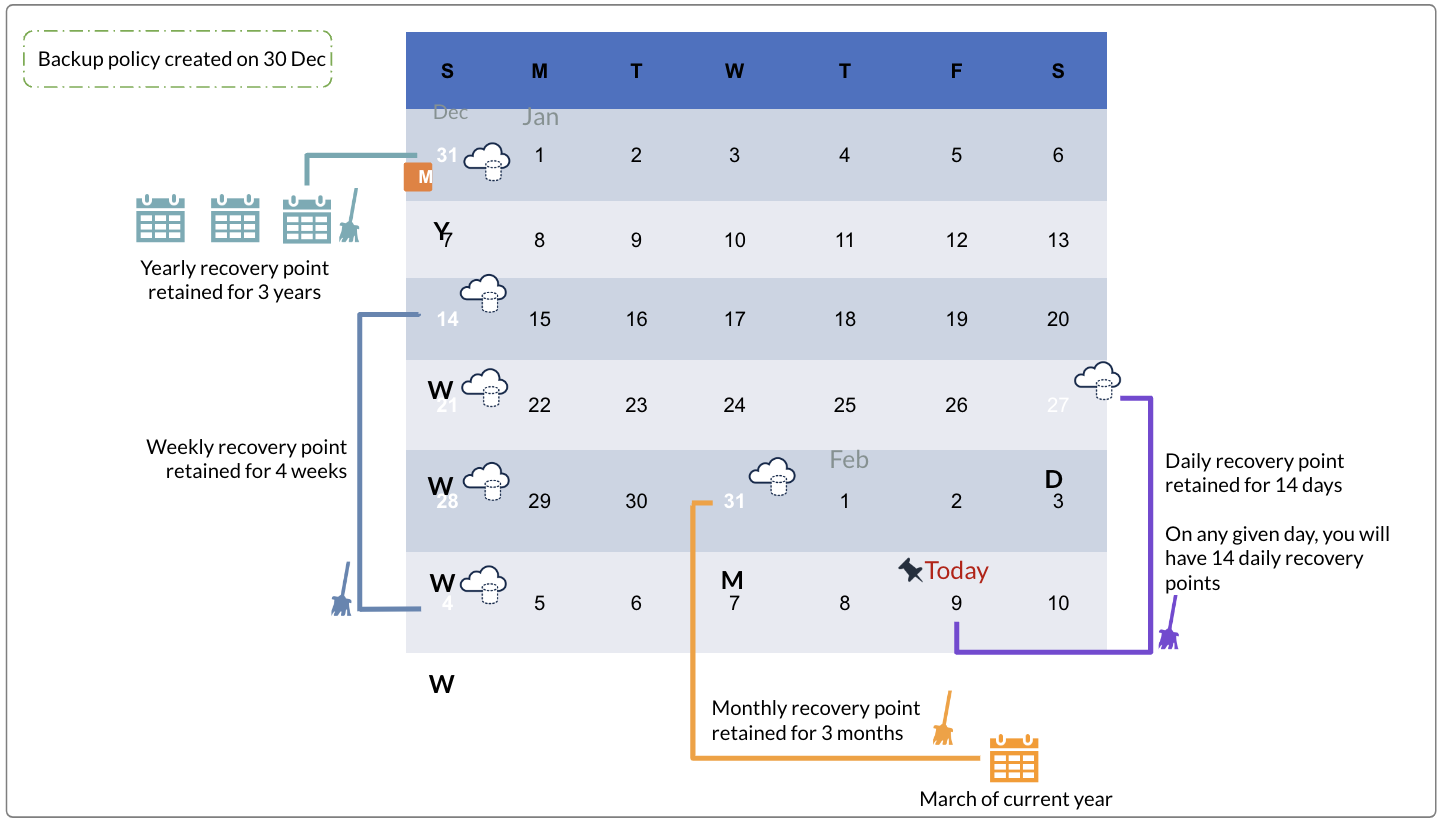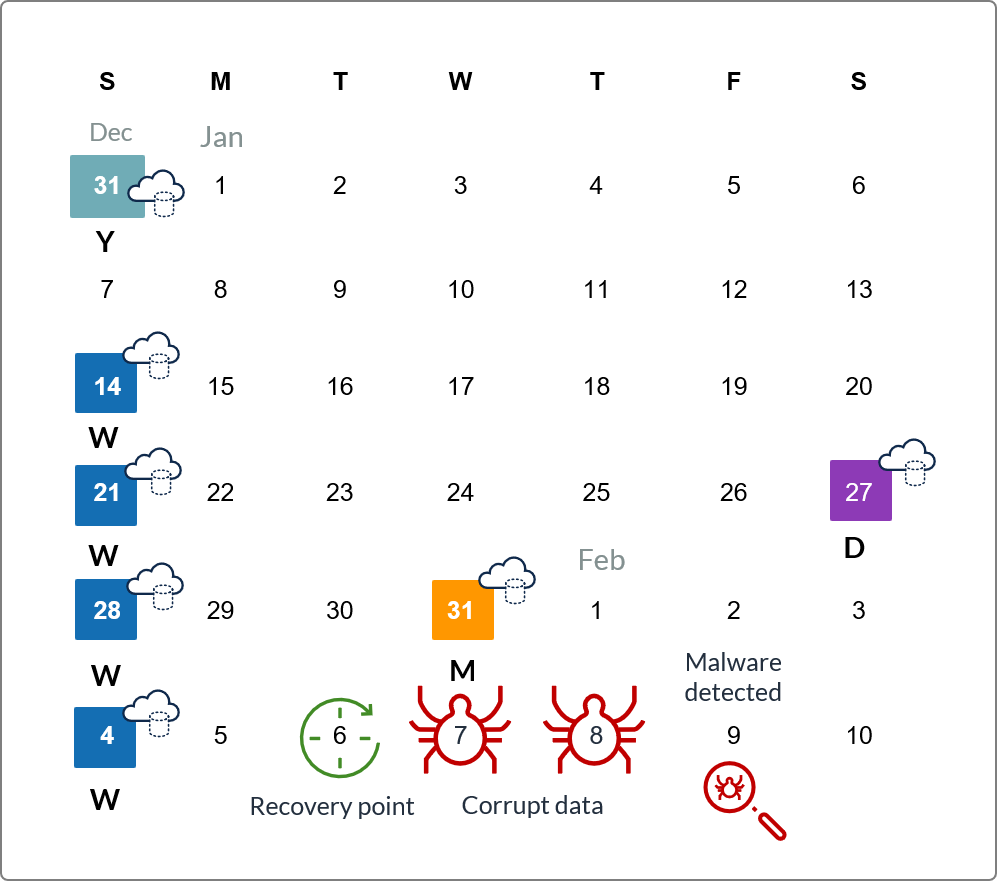Manage Backup Policy
 Business
Business  Enterprise
Enterprise  Elite
Elite
Overview
A backup policy is a set of rules that define the schedule and retention of backups of virtual machines configured for backup. When you assign a backup policy to one or more virtual machines, the machines are backed up according to the schedule in the policy. Backup policies help administrators simplify data management of data backups across multiple virtual machines.
Note: Backup operations follow the time zone of the Backup proxy pool.
Managing retention period
Create a Nutanix backup policy
Create new Nutanix AHV backup policies to backup virtual machines on different schedules and retain the backups for different durations. You can also create a copy of existing backup policies and modify them as per requirements.
Procedure
- Log in to the Management Console.
- Select your Organization if Organizations are enabled
- On the menu bar, click Protect > Nutanix AHV.
- On the Nutanix AHV page, in the navigation pane on the left, click Backup Policies.
- On the Backup Policies page, click New Backup Policy.

- In the New Backup Policy dialog box, perform the following tasks:
- General tab
-
- ►Expand to view image

- Name: Enter a name for the backup policy.
- Description (optional): Enter an optional description for the backup policy
-
- Backup Schedule tab
-
- ►Expand to view image
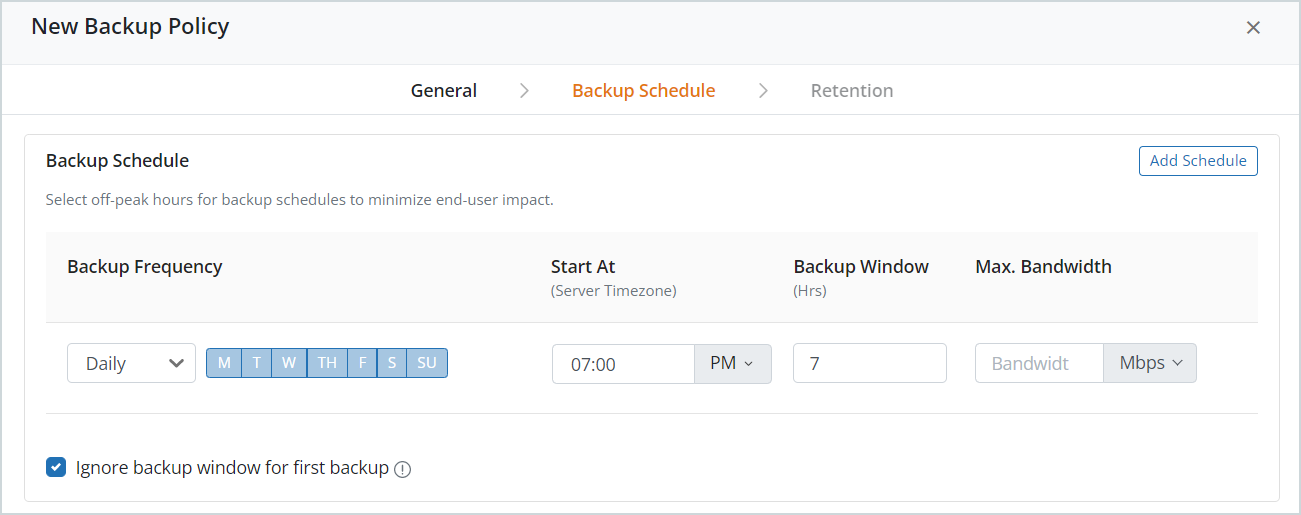
- Backup Frequency: Select a frequency for the scheduled backups from Daily, Weekly, or Hourly. Also, select the days of the week when the backups should run if the frequency is Weekly or Hourly.
- Start At (Server Timezone): Select a time when the scheduled backups must start. Ensure that the backups start during off-peak hours. Backup operations follow the time zone of the Backup proxy pool.
- Backup Window: Enter the number of hours for which the backup must run. Example
If you set Start At to 01:00 AM and you set the duration to 6 hours, backups of your server start at 01:00 AM and stop at 07:00 AM, even if they do not complete - Max Bandwidth: The maximum bandwidth that each virtual machine can consume while backing up data to Druva. You can enter the bandwidth in Mbps or Gbps.
Note: The maximum bandwidth that a backup job can consume is 2 Gbps (2048 Mbps).
For a scheduled backup, the job will consume the assigned bandwidth. However, for manually triggered backups, the job will consume the available bandwidth on your network
- Ignore backup window for first backup: By default, the Ignore backup window for the first backup option is enabled. When this option is enabled, it ignores the specified backup duration until the first backup job is complete. The first backup job is complete when the first recovery point is created. You can disable this option to enforce backup duration for the first backup jo
-
- General tab
- Click Add Schedule to add multiple schedules, and then click Next.
- In the Retention tab, perform the following tasks:
- ►Expand to view image
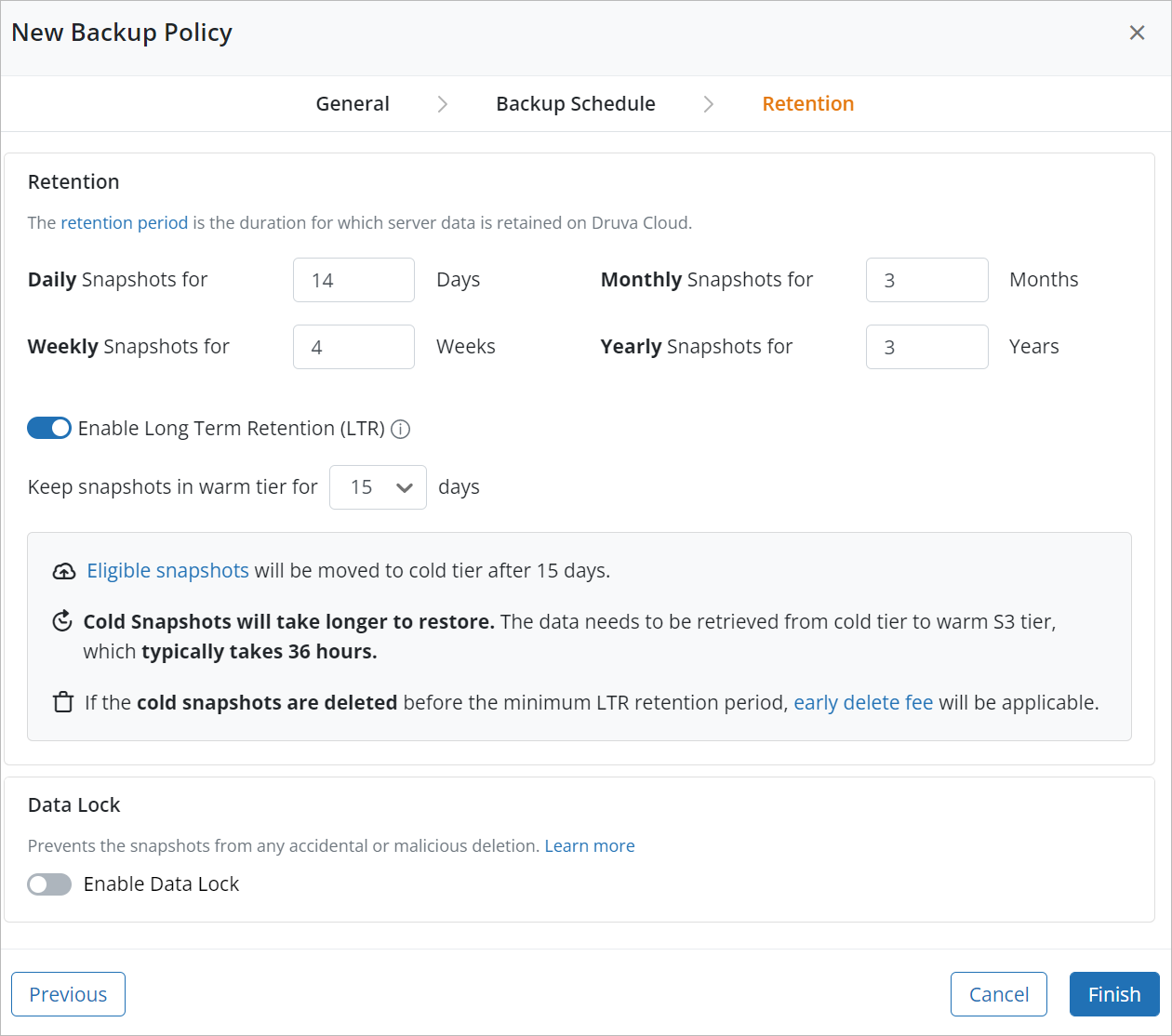
| Field | Task |
|---|---|
| Daily recovery points for | Enter the number of days for which you want to retain all the daily recovery points. |
| Monthly recovery points for | Enter the number of months for which you want to retain the latest monthly recovery points. |
| Weekly recovery points for | Enter the number of weeks for which you want to retain the latest weekly recovery points. |
| Yearly recovery points for | Enter the number of years for which you want to retain the latest yearly recovery points. |
| Enable Long Term Retention | Toggle to enable or disable LTR for the backup policy. You can enable LTR only if the retention period is greater than or equal to one year. To know more about LTR, refer to About Long Term Retention. In the Keep recovery points in warm tier drop-down list, specify the duration in days to retain the recovery points in the warm tier. For example, 15, 30, 45, and 60 days. To know more about the impact of changing the threshold on the existing recovery points, see Impact of changing threshold on existing snapshots. |
| Enable Data Lock | Toggle to enable the Data Lock for the backup policy. For more information about Data Lock, refer to Data Lock.
Note: Once you apply Data Lock to the backup policy, you cannot: |
Note: Ensure that you enter a value in at least one of the Daily, Weekly, Monthly, or Yearly recovery point fields. Hybrid Workloads treats the values in the empty fields as zero.
- Click Finish. The backup policy is created and listed on the Backup Policies page. You can now assign the backup policy to virtual machines.
Update a backup policy
You can update existing Nutanix backup policies at any time as per your requirements.
Procedure
- Log in to the Management Console.
- Select your Organization if Organizations are enabled.
- On the menu bar, click Protect > Nutanix AHV.
- On the Nutanix AHV page, in the navigation pane on the left, click Backup Policies.
- On the Backup Policies page, click the backup policy that needs to be edited.
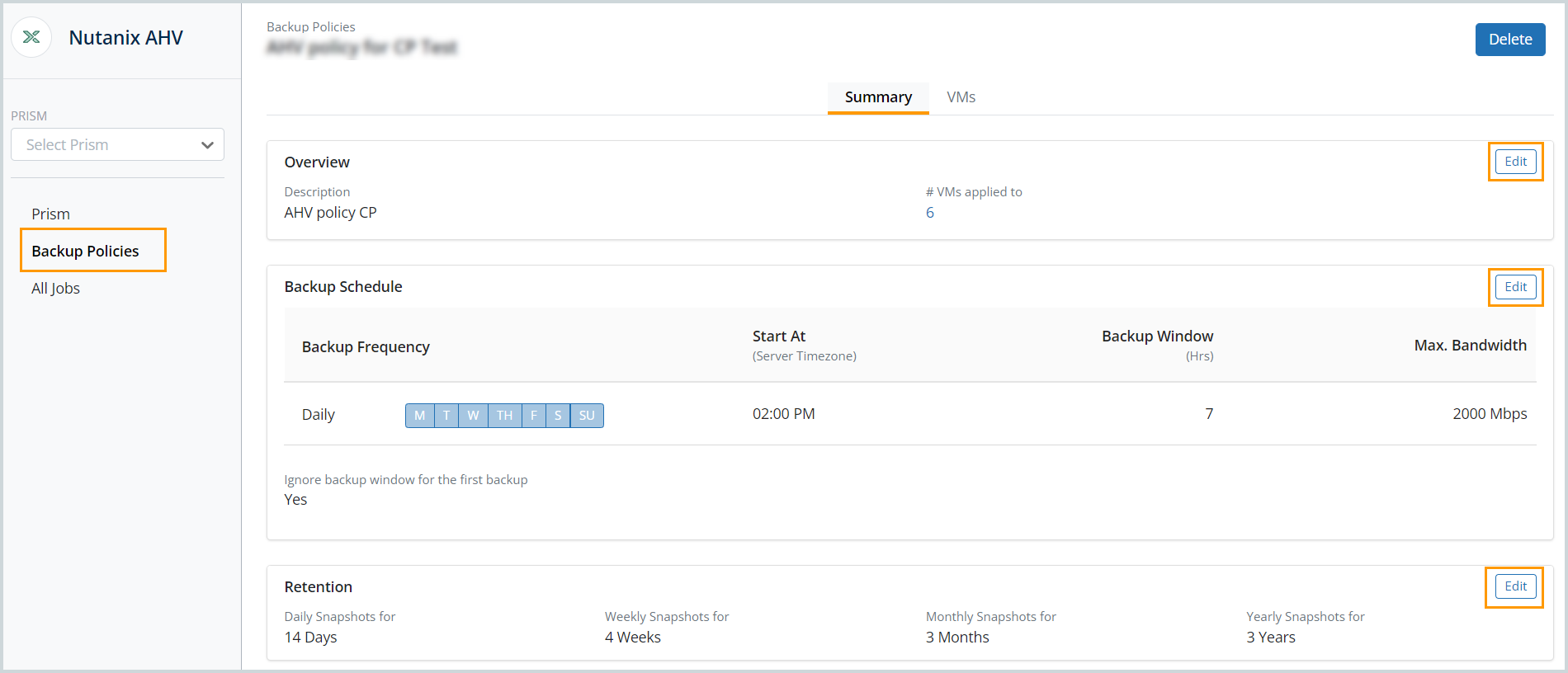
- On the backup policy details page, you can update the following:
- Overview: You can edit the policy name and description.
- Backup Schedule: You can edit the backup frequency, start time, backup window, and maximum bandwidth. You can also add or delete schedules.
- Retention: You can change the duration for which you want to retain the daily, weekly, monthly, or yearly recovery points.
Duplicate a Nutanix backup policy
Duplicating existing Nutanix backup policies allows you to create copies of existing policies and edit only the required sections. The duplicated policies are identical to the original backup policy and save you the hassle of creating a policy from scratch.
Procedure
- Log in to the Management Console.
- Select your Organization if Organizations are enabled.
- On the menu bar, click Protect > Nutanix AHV.
- On the Nutanix AHV page, in the navigation pane on the left, click Backup Policies.
- On the Backup Policies page, select the policy that must be duplicated and click Duplicate Policy.

- In the Duplicate Policy dialog box, enter the following details:
- Selected backup policy: This field is greyed out and is the name of the backup policy that is being duplicated.
- New backup policy name: Enter the name for the new backup policy.
- Description (Optional): Enter an optional description for the backup policy.
- Click Save. This creates a new backup policy with settings similar to the original backup policy. The new policy is listed on the Backup Policies page.
Click the name of the new backup policy to view details. You can edit the backup policy as per your requirements and save it. You can then assign this backup policy to one or more virtual machines. The virtual machines are then backed up as defined in the policy.
View list of virtual machines associated with a backup policy
- Log in to the Management Console.
- Select your Organization if Organizations are enabled.
- On the menu bar, click Protect > Nutanix AHV.
- On the Nutanix AHV page, in the navigation pane on the left, click Backup Policies.
- On the Backup Policies page, click the policy for which you want to see the list of associated virtual machines.
- On the Backup Policies details page, click the VMs tab.

- The VMs tab displays the list of virtual machines that use this backup policy. You can click the VM name to view VM details.
Delete a backup policy
Only a cloud administrator can delete a Nutanix backup policy from the Management Console provided no virtual machines are using the backup policy you want to delete. If a backup policy you want to delete is associated with one or more virtual machines, reconfigure the virtual machines one by one and select a different backup policy for them. For details, see Reconfigure a virtual machine.
Note: You can delete a backup policy only after 7 days of the deletion of the last configured virtual machine mapped to the policy.
Procedure
- Log in to the Management Console.
- Select your Organization if Organizations are enabled.
- On the menu bar, click Protect > Nutanix AHV.
- On the Nutanix AHV page, in the navigation pane on the left, click Backup Policies.
- Click the Nutanix backup policy that you want to delete.
- On the backup policy details page, click Delete.
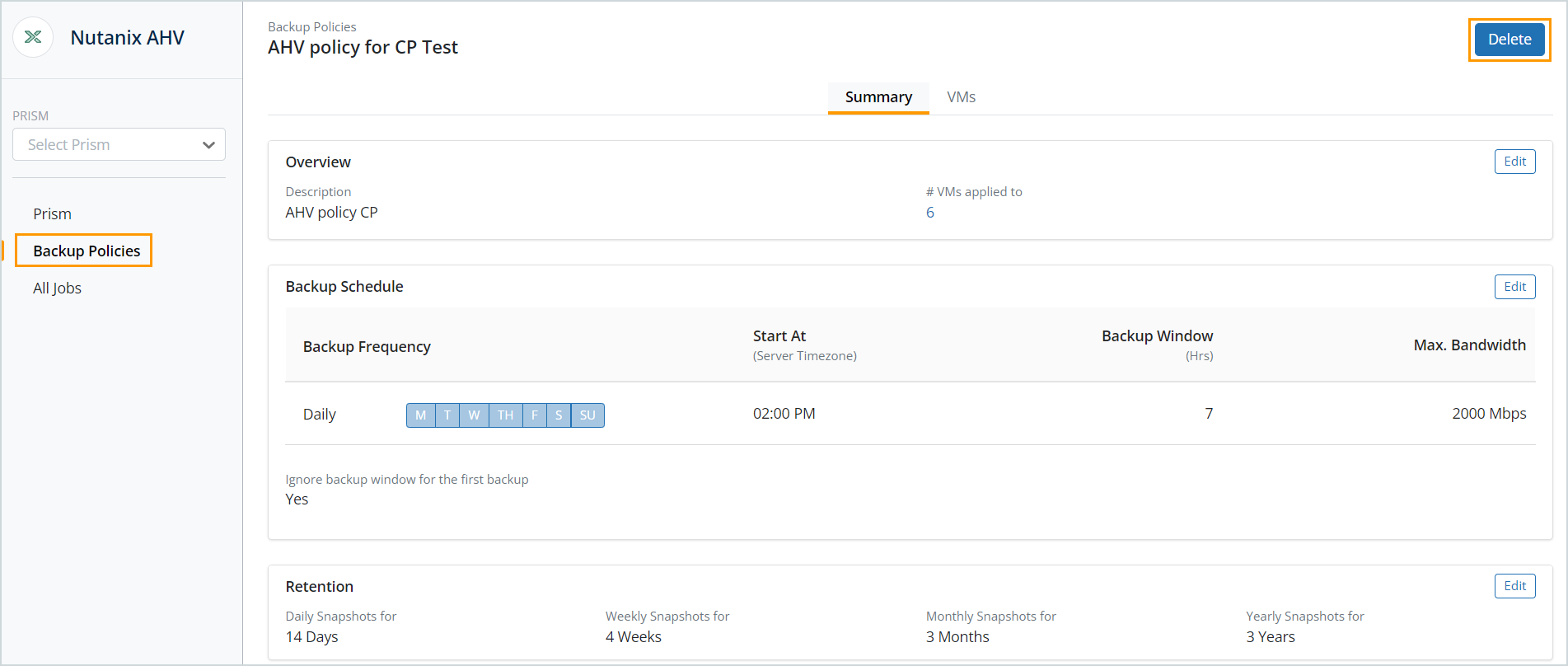
- Click Yes on the confirmation dialog box.
Change a backup policy
You can change the backup policy for one or more existing virtual machines (VMs) anytime as per your requirements.
Procedure
- Log in to the Management Console.
- Select your Organization if Organizations are enabled.
- On the menu bar, click Protect > Nutanix AHV.
- On the Prism page, click the Prism Element or Prism Central that manages the virtual machine for which you want to change the backup policy. Alternatively, select the Prism Element or Prism Central from the Prism dropdown menu.
- In the left navigation pane, click Configured VMs.
- Select one or more VMs for which you need to change the backup policy.
- Click more options and then select Change Backup Policy.

- In the Change Backup Policy dialog box, select the desired policy from the available policies in the Change Backup Policy to dropdown list.

- Click Save. The backup policy is successfully changed for the selected VMs.


